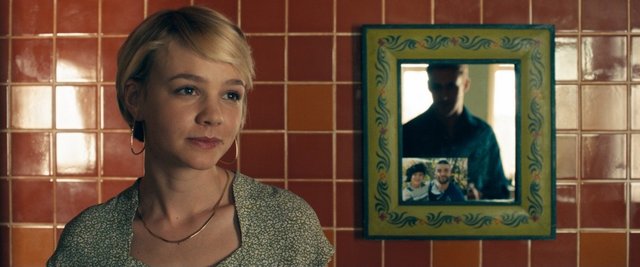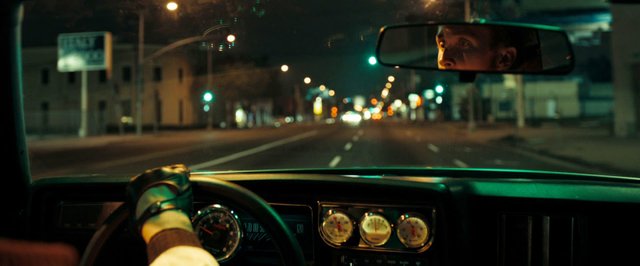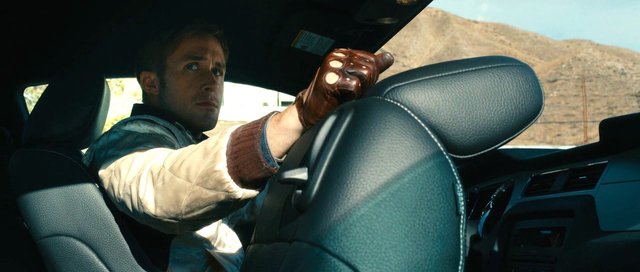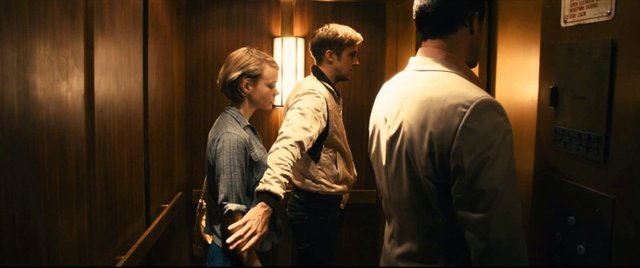🎬 FILM ANALYSIS : Drive

Drive, directed by Nicolas Winding Refn was one of the most stunning and unique films of 2011. Absolutely every single shot, every camera movement is there for a purpose. Refn tries to tell a story with the compositions more than with dialogue.
I won't be doing introduction or analysis of the film plot here, rather I would be concentrating on film aesthetics,
so you will have had to seen the movie in order to understand this article.
Compositions are in perfectly balanced shots that always communicate something, for example, we can take the relationship between Driver and Irene. At beginning of the film they are always either in separate shots or when they are in the same shot together, like in this one bellow, when we see him entering inside Irene's apartment for the first time, he is in the mirror reflection, but there is also a picture of her husband and son, and he feels like an intruder.

THE QUADRANT SYSTEM CINEMATOGRAPHY
Tony Zhou’s masterful "Every Frame a Painting" series tries to explain the so called ''quadrant system'' of compositions in Drive.
Zhou shows how the film comes "alive" by taking a few scenes and dividing them into quadrants, demonstrating how Refn uses an otherwise conventional storytelling tool to do unconventional things. Shots that split the actors left and right help tell two different stories at the same time. Splitting top to bottom helps the characters show their inner feelings through gestures and fidgeting in a way that faces and dialogue can't. The effect makes Drive predictable and unpredictable at the same time, and stands in stark contrast to the geometric perfection of Wes Anderson films.
The framing technique additionally allows us to be constantly entertained in our viewing experience. Though the storytelling is similar across each quadrant, the allowance for our eyes to wander through the frame keeps us engaged and "in" the film.
CAR SEQUENCES
(Interview with DOP Newton Thomas Sigel for HD Video Pro)

Drive has three major car sequences, none of which, per the director’s wishes, features handheld shooting. “Each of the car actions has its own signature look,” Sigel relates, “which was based on the point at which we were in the arc of this character’s story. When you first meet him, as he picks up two guys who just robbed a store, it’s all very subjective. The camera movement was designed to take place inside the car, all told from the driver’s perspective, usually over his shoulder when he was watching for police cars, or occasionally looking at Ryan to see his reactions.”
The second car chase, taking place in the desert during broad daylight, comes about when Driver helps Irene’s husband. “It’s a job he probably shouldn’t have taken,” Sigel opines. “That segment really recalls ’70s-era car action, with a lot of high-velocity car-to-car shooting—and then Nicolas puts his unique turn on things, so we start turning things around expectations-wise. While being pursued, Ryan’s character spins a 180 and winds up going backwards, in the process luring the other car into a big crash. It wasn’t ever just about homage to past films because we would always kick it up beyond that.” For slow-motion moments, a Phantom high-speed camera was employed.

The film’s final car sequence has Driver acting as pursuer. “We did that focusing on the car as a character, a living, breathing predatory form,” Sigel states. “The angles chosen emphasize that aspect, and so the grip crew were rigging speed rail all over, and we had a lot of car rigs. One we used was the Ultimate Arm, which is a remote-controlled crane sitting atop the chase vehicle. It was an extremely flexible and useful tool, with one person operating the crane while another handles the head for panning action.
LIGHTNING
Refn's characters are almost always half covered in shadows, they will always stand in just the right part of the frame to make the frame as impactful as it can be, his Los Angeles is the kind of Los Angeles that only exists in movies

While nearly all of the film features a naturalistic approach to lighting, a memorable encounter in an elevator steps out from that level of reality. When Irene faces a menacing situation, Driver reveals his darkest colors, and the love scene switches from beauty to violence in a fraction of second.In the interview for HD Video Pro, director of photography Newton Thomas Sigel said “He goes over the line in defending her, but just before he acts, there’s a moment when we put in a lighting cue [with gels and dimmers] that lets the movie go to a fantasy place for just a moment; you could call it heightened or stylized reality, I guess. He takes her hand, gives her a kiss, and in this moment, you see what might have been between them; then it reverts back to the cooler elevator lighting, as he does what he needs to do, going way beyond the call of duty. This moment, when Irene sees him go psychotic, changes her perception of him and alters her notion of trusting him or thinking about ever being with him.”
EXTERNAL LINKS
Video interview with director Nicolas Winding Refn that was posted by DP/30
WARNING! The comment below by @shovon51 leads to a known phishing site that could steal your account.
Do not open links from users you do not trust. Do not provide your private keys to any third party websites.
upvote for me please? https://steemit.com/news/@bible.com/6h36cq
love this movie 🚗😊
Hello @marinauzelac, thank you for sharing this creative work! We just stopped by to say that you've been upvoted by the @creativecrypto magazine. The Creative Crypto is all about art on the blockchain and learning from creatives like you. Looking forward to crossing paths again soon. Steem on!
Very Nice. Look here and I will provide you more votes http://mcg6000.com/booster